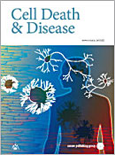
Cell and Bioscience
Scope & Guideline
Unlocking the Secrets of Life at the Cellular Level
Introduction
Aims and Scopes
- Cellular Mechanisms and Signaling Pathways:
Research articles often explore intricate signaling pathways and cellular mechanisms, including the role of various proteins, RNA modifications, and metabolic processes in health and disease. - Stem Cell Biology and Regenerative Medicine:
The journal frequently publishes studies on stem cell biology, differentiation, and their therapeutic applications in regenerative medicine and tissue engineering. - Cancer Biology and Therapeutics:
A significant portion of the research focuses on cancer biology, examining tumor biology, metastasis, and exploring novel therapeutic strategies and biomarkers. - Neuroscience and Neurodegenerative Diseases:
The journal addresses various aspects of neuroscience, including neural development, neuroinflammation, and neurodegenerative diseases, contributing to a better understanding of brain-related disorders. - Microbiology and Infectious Diseases:
Research on host-pathogen interactions, immune responses, and the development of therapeutic interventions against infectious diseases is a prominent theme. - Metabolism and Disease:
Studies related to metabolic disorders, their cellular mechanisms, and potential therapeutic interventions are also key areas of focus.
Trending and Emerging
- RNA Modifications and Epitranscriptomics:
There is a growing emphasis on the role of RNA modifications, particularly m6A and other epitranscriptomic changes, in regulating gene expression and their implications in various diseases, including cancer and neurodegenerative disorders. - Microbiome and Host Interactions:
Research exploring the interplay between the microbiome and host health is on the rise, particularly its influence on metabolic diseases, immune responses, and cancer progression. - Organoid Models for Disease Modeling:
The use of organoid technology is increasingly prominent, providing innovative platforms for studying disease mechanisms and testing therapeutic interventions in a more physiologically relevant context. - Immunotherapy and Cancer Immunology:
Publications focusing on the mechanisms of immunotherapy, including the role of immune checkpoints and the tumor microenvironment, are trending as researchers seek to enhance treatment efficacy. - Metabolic Reprogramming in Cancer:
Emerging studies are increasingly focusing on the metabolic pathways in cancer cells, exploring how metabolic reprogramming contributes to tumorigenesis and resistance to therapies. - Gene Editing Technologies and Applications:
The application of CRISPR/Cas9 and other gene editing technologies is gaining traction, with research exploring their potential in therapeutic contexts and the ethical implications surrounding their use.
Declining or Waning
- Basic Mechanisms of Epithelial-Mesenchymal Transition (EMT):
Although EMT has been a significant area of study in cancer biology, the frequency of publications focusing solely on the mechanistic aspects of EMT appears to be decreasing, possibly due to a shift towards more integrative approaches that encompass broader cellular interactions. - Traditional Pharmacological Approaches:
There is a noticeable reduction in studies highlighting traditional pharmacological interventions, as the journal's focus is increasingly leaning towards innovative therapies, including gene editing and personalized medicine. - In Vitro Models of Disease:
The use of conventional in vitro models is becoming less prominent, as researchers are moving towards more complex and physiologically relevant models such as organoids and 3D cultures. - Single-Cell Analysis Techniques:
While single-cell technologies have gained significant attention, the specific focus on traditional single-cell sequencing methods is waning, with a greater emphasis now on integrating these techniques with spatial transcriptomics.
Similar Journals

CELLULAR AND MOLECULAR LIFE SCIENCES
Empowering Global Collaboration in Life Sciences ResearchCELLULAR AND MOLECULAR LIFE SCIENCES, published by SPRINGER BASEL AG, stands as a premier journal dedicated to advancing the field of cellular and molecular biology. With an impressive 2023 impact factor reflected in its Q1 rankings across key categories—including Cell Biology, Molecular Biology, and Pharmacology—it serves as a critical platform for researchers aiming to disseminate high-quality findings in these dynamic fields. Operated under an open access framework, the journal allows broader accessibility to groundbreaking research, fostering collaboration amongst scientists globally. Based in Switzerland, CELLULAR AND MOLECULAR LIFE SCIENCES has been at the forefront of scientific publishing since 1952, adapting to contemporary scientific challenges and trends, ultimately shaping the future of life sciences.

NEUROCHEMISTRY INTERNATIONAL
Unveiling Insights in Cellular and Molecular NeuroscienceNEUROCHEMISTRY INTERNATIONAL, published by Pergamon-Elsevier Science Ltd, offers a premier platform for researchers and professionals in the realms of cell biology and cellular and molecular neuroscience. Established in 1980 and continuing its passion for advancing the field, this esteemed journal enhances scientific collaboration with a notable 2023 Q2 ranking in both relevant categories, placing it among the top-tier publications in its discipline with a Scopus rank of 23/97 for Cellular and Molecular Neuroscience. With its focus on groundbreaking research, the journal provides a wealth of vital data and insights that drive forward our understanding of neurochemistry and its implications in health and disease. While not an Open Access journal, NEUROCHEMISTRY INTERNATIONAL is integral for professionals, academics, and students aiming to stay at the forefront of neurobiological research innovations, making significant contributions to both academia and clinical applications.

FEBS Journal
Unlocking the Secrets of Biochemistry and Cell BiologyFEBS Journal is a prestigious, peer-reviewed publication dedicated to advancing the field of biochemistry, cell biology, and molecular biology. Published by WILEY in the United Kingdom, this journal boasts an impressive impact factor and ranks in the top quartile (Q1) across multiple relevant categories, including Biochemistry, Cell Biology, and Molecular Biology, reflecting its significant contribution to scientific research. With an ISSN of 1742-464X and an E-ISSN of 1742-4658, the FEBS Journal publishes original research and comprehensive reviews that push the boundaries of knowledge and innovation in the biosciences. As a vital resource for researchers, professionals, and students alike, the journal offers Open Access options, ensuring that cutting-edge discoveries are accessible to a broad audience. With a publication history converging from 2005 to the present and a robust emphasis on high-quality scholarly work, the FEBS Journal remains an essential platform for the dissemination of significant findings and advancements in the life sciences.

CELL RESEARCH
Transforming Discoveries into KnowledgeCELL RESEARCH is a premier peer-reviewed journal dedicated to advancing the field of cell biology and molecular biology, published by SpringerNature. With an impressive impact factor and consistently ranking in the Q1 quartile for both cell biology and molecular biology, this journal serves as a pivotal resource for researchers, professionals, and students seeking to explore the latest discoveries and advancements in cellular mechanisms and their implications for health and disease. Since its inception in 1996, CELL RESEARCH has cultivated a distinguished reputation, currently boasting ranks in the top percentile of Scopus categories, reaffirming its influence and relevance to the scientific community. Although it is not an Open Access journal, its rigorous selection process ensures the publication of high-quality articles that contribute significantly to our understanding of life sciences. For those deeply engaged in the realms of biochemistry, genetics, and molecular biology, CELL RESEARCH is an essential conduit of innovative research and critical insights.

Protein & Cell
Pioneering Discoveries in Protein Functions and Cellular ProcessesProtein & Cell, published by Oxford University Press, is a distinguished international journal focusing on cutting-edge research in the fields of biochemistry, biotechnology, cell biology, and drug discovery. This open access journal, active since 2014, is dedicated to disseminating innovative findings that advance our understanding of protein functions and cellular processes, making it an essential resource for researchers, professionals, and students alike. With an impressive 2023 impact factor reflected in its Q1 ranking across multiple categories such as Biochemistry, Drug Discovery, and Cell Biology, 'Protein & Cell' stands at the forefront of scientific research, driving collaboration and discussion in the scientific community. Researchers can access the journal freely online, fostering a global exchange of knowledge and contributing to significant advancements in medicine and biotechnology. Located in the United Kingdom, the journal strives to be a pivotal platform for impactful research that influences future studies and applications.

Cell Death & Disease
Leading the charge in transformative biomedical discoveries.Cell Death & Disease, published by SpringerNature, is a premier open-access journal dedicated to disseminating high-quality research on the mechanisms and implications of cell death, disease pathology, and therapeutic responses. Since its inception in 2010, the journal has quickly established itself within the top tier of academic publishing, achieving a notable impact factor and earning Q1 rankings in several critical categories including Cancer Research, Cell Biology, Cellular and Molecular Neuroscience, Immunology, and Medicine (miscellaneous). With its commitment to open access, Cell Death & Disease ensures that groundbreaking research is available to a global audience, fostering collaboration and advancing knowledge across disciplines. Residing at the forefront of crucial scientific discourse, this journal not only attracts submissions from leading researchers but also significantly influences the fields of molecular biology, immunology, and neurology. By bridging the gap between basic science and clinical applications, it provides vital insights for professionals, academicians, and students alike.

Biology Direct
Driving collaboration in the biological sciences.Biology Direct is a leading open-access journal published by BMC, dedicated to disseminating groundbreaking research in the fields of biological sciences. Since its inception in 2006, the journal has emerged as a pivotal platform for scholars, researchers, and practitioners, providing unrestricted access to high-quality, peer-reviewed articles that cover a wide spectrum of topics, including biochemistry, ecology, and applied mathematics. With an impressive ranking in the first quartile across multiple scientific categories, including Agricultural and Biological Sciences and Biochemistry, Genetics, and Molecular Biology, Biology Direct is recognized for its rigorous standards and impactful contributions within the academic community. The journal's open-access model ensures that research findings reach a global audience, fostering collaboration and innovation. Researchers and students looking to stay ahead in the rapidly evolving biological sciences will find Biology Direct an invaluable resource for knowledge and insight.

ACTA HISTOCHEMICA
Exploring the Cellular Landscape Through Histochemical InnovationACTA HISTOCHEMICA, a prestigious journal published by Elsevier GmbH, is dedicated to advancing the field of histochemistry and its applications within cell biology and medicine. With an ISSN of 0065-1281 and an E-ISSN of 1618-0372, the journal provides a critical platform for the dissemination of high-quality research findings and reviews, integral for both emerging and established scholars. Since its inception in 1954 and continuing through to 2024, ACTA HISTOCHEMICA has maintained a strong commitment to publishing significant advancements in histology and cell biology, as evidenced by its categorization in Q3 for Cell Biology and Histology, as well as Q2 in miscellaneous medicine for the year 2023. The journal ranks favorably in Scopus, holding the 27th rank in Histology and a 200th rank in Cell Biology, highlighting its importance to the academic community. With its headquarters in Munich, Germany, ACTA HISTOCHEMICA continues to attract contributions from global researchers, fostering an international dialogue essential for the growth of knowledge in histochemistry and related disciplines.

LIFE SCIENCES
Advancing knowledge in the life sciences since 1962.LIFE SCIENCES, published by PERGAMON-ELSEVIER SCIENCE LTD, is an esteemed international journal that has been advancing the field since its inception in 1962. With an ISSN of 0024-3205 and an E-ISSN of 1879-0631, it serves as a critical forum for researchers, professionals, and students within the realms of biochemistry, genetics, molecular biology, medicine, and pharmacology. Currently ranked in the Q1 category across multiple disciplines, including a remarkable 2nd rank in General Pharmacology, Toxicology, and Pharmaceutics, the journal maintains a prestigious position in academic circles, evidenced by its high impact factor and significant percentile ranks. While LIFE SCIENCES is not an open-access journal, it remains dedicated to publishing high-quality, peer-reviewed research that pushes the boundaries of knowledge and fosters innovation. With converged research interests leading into 2024, LIFE SCIENCES continues to be a pivotal resource for the dissemination of influential findings, making it an indispensable tool for those engaged in the life sciences.

MOLECULAR AND CELLULAR BIOCHEMISTRY
Advancing the Frontiers of Biochemical ResearchMOLECULAR AND CELLULAR BIOCHEMISTRY, an esteemed journal published by SPRINGER, serves as a prominent platform in the fields of biochemistry and molecular biology. With a history of dissemination since 1973, this journal has made significant contributions to the understanding of biochemical processes at the molecular level. The MOLECULAR AND CELLULAR BIOCHEMISTRY journal focuses on a myriad of topics including but not limited to cellular biochemistry, clinical biochemistry, and interdisciplinary approaches in medicine, boasting a commendable categorization in the 2023 Scopus ranks where it falls under Q3 in Cell Biology, Q2 in Clinical Biochemistry, Q1 in Medicine (miscellaneous), and Q2 in Molecular Biology. Although the journal is not open access, it provides access options through institutional subscriptions, making valuable research accessible to a wider audience. With its rigorous peer-review process and high impact within the scientific community, this journal aims to advance knowledge and stimulate exploration in biochemical research, making it essential reading for researchers, professionals, and students alike.